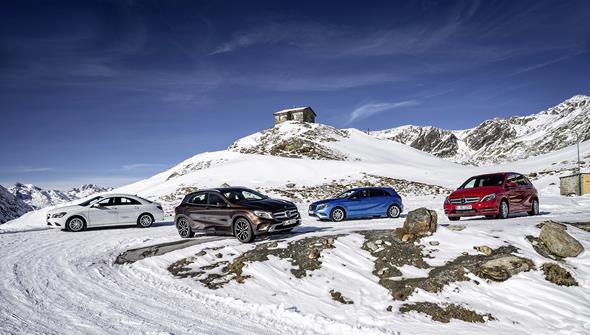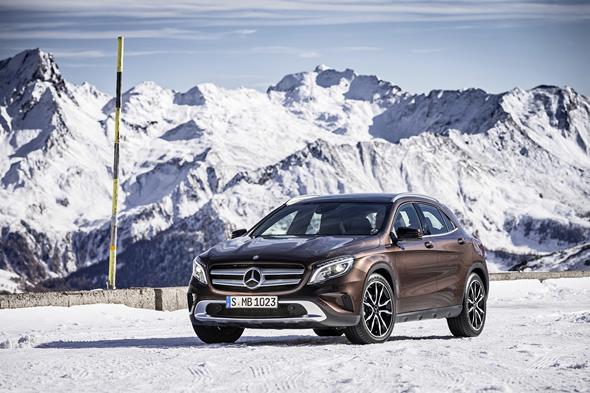The summit of perfection with the 4MATIC compact class family


All-wheel drive for all – tailor-made solutions
Stuttgart/Hochgurgl
The 4×4 family from Mercedes-Benz currently comprises more than 60 models. This means that a 4×4 technology solution tailored to the respective vehicle class is always available – from the new compact class model family and the vehicles of the C, E, S, CLS and CL-Class, through to the comprehensive range of SUVs and cross-country vehicles that make up the GLA, GLK, M, GL and G-Class ranges.
Features common to all include high reserves of traction and outstanding agility, along with optimum handling safety and energy efficiency.
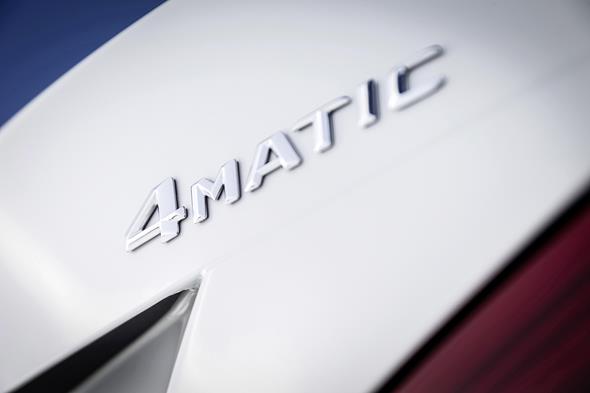
At this year’s 4MATIC Workshop taking place in the wintery conditions of Hochgurgl, Austria, the focus is squarely on the compact class model family.
The A, B and CLA-Class are now all optionally available with the new generation of the 4MATIC permanent all-wheel-drive system featuring fully variable torque distribution. In addition, from March 2014 the new GLA will be joining the Mercedes-Benz SUV model range.
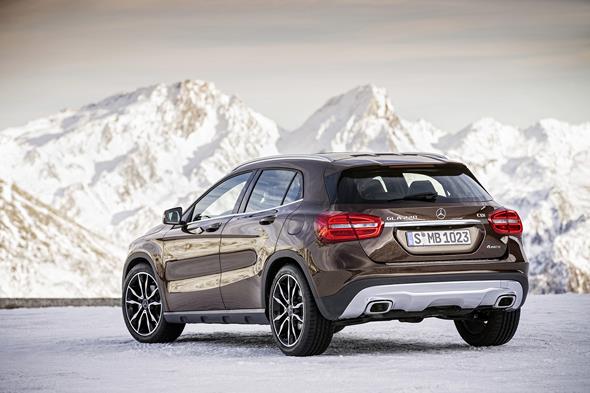
The most innovative components of the new 4MATIC include the power take-off to the rear axle, which is integrated into the 7G-DCT automated dual clutch transmission, and the rear-axle gear unit with integrated, hydraulically actuated multi-disc clutch.
This set-up allows fully variable distribution of the drive torque between the front and rear axles. Additional benefits of this design are a lower system weight compared with the competition and also high efficiency. As with their front-wheel-drive counterparts, all 4MATIC models also boast good energy efficiency.
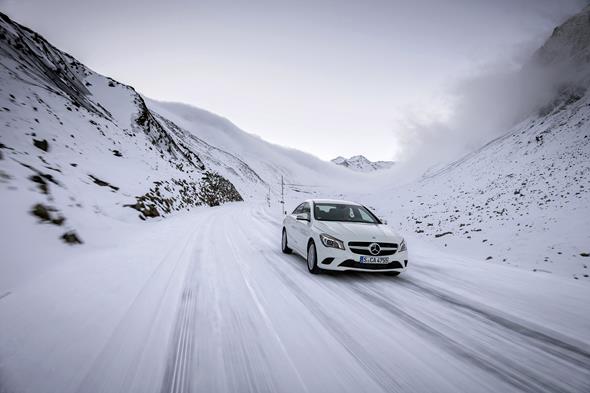
Integrated power take-off unit (PTU) channels power to the rear axle
The new 4MATIC is combined with the 7G-DCT seven-speed automated dual clutch transmission. The power flow to the rear drive train is provided by a compact power take-off unit (PTU) which is fully integrated into the main transmission and is supplied with lubricant from the latter’s oil circuit.
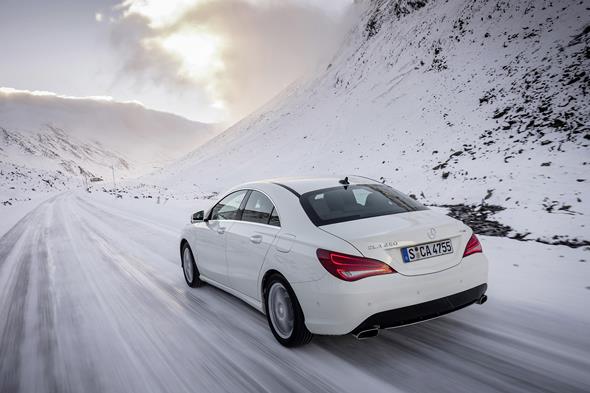
This configuration gives rise to substantial weight advantages over competitor systems that branch off power by means of an add-on component with its own oil circuit. In conjunction with the friction-minimised tapered roller bearings, the PTU thus achieves an excellent level of efficiency.

The low system weight of the 4MATIC system is not attributable solely to the PTU. Other weight-stripping measures include a compact rear-axle gear unit, inductively hardened, weight-optimised rear-axle side shafts and weight-optimised drive shafts.
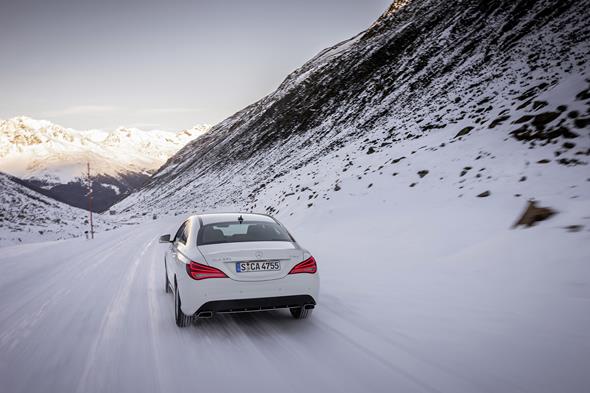
The system weight of this 4MATIC is up to 25 percent lower than in the all-wheel-drive versions offered by the competition.
The two-piece drive shaft is vibrationally decoupled. An axially moving joint at the front compensates for longitudinal movements of the engine transmission unit, while an elastic flexible coupling reduces the intrusion of high-frequency gearing vibrations at the rear-axle gear unit.
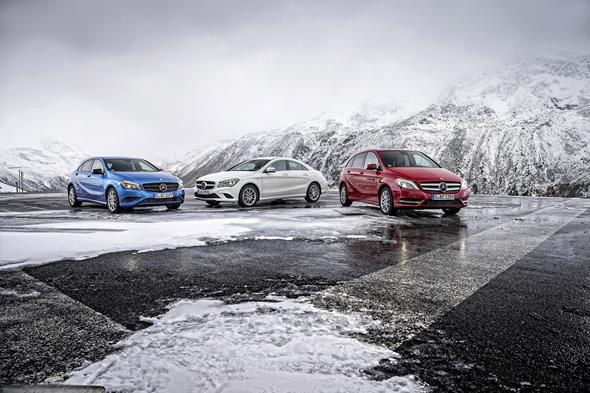
To minimise crash loads, the drive shaft is fitted with an extendable element.
Completely new development with torque-on-demand rear axle
The hydraulically actuated multi-disc clutch integrated into the rear-axle gear unit is responsible for fully variable torque distribution. Fundamental operating principle: when the multi-disc clutch is open, the car is driven exclusively by the front axle.
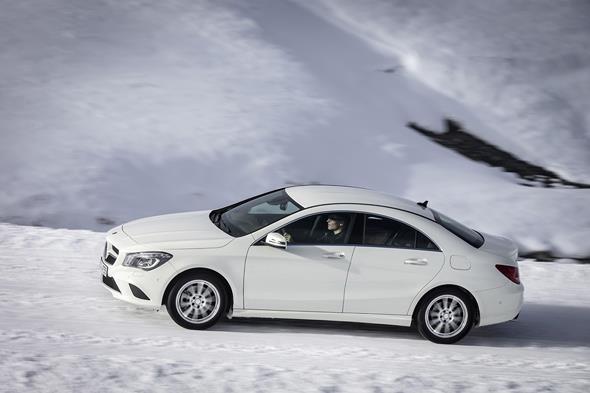
When the clutch is closed, the rear axle comes into play. However, the drive torque can be shifted in fully variable mode between front and rear axle according to the given situation (torque on demand).
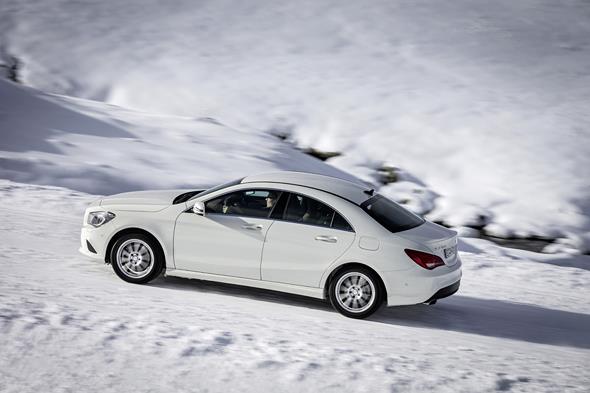
The system pressure to activate the rear axle is supplied in milliseconds by the gerotor pump that is integrated into the rear-axle gear unit.
The pump is activated automatically as soon as only minimal speed differences arise between front and rear axles, and pressure control and therefore torque control to the rear axle is performed by means of a proportioning valve integrated into the rear axle.

Motoring enjoyment thanks to intelligent control systems
The 4MATIC is activated according to the basic principle of “as often as necessary, as rarely as possible”. This means that when the underlying conditions allow, the all-wheel-drive compact models run in particularly economical front-wheel-drive mode.
As soon as the driving situation requires, drive torque is channelled to the rear axle as appropriate.
The reverse process takes place just as quickly: as soon as additional drive torque is no longer necessary at the rear axle – e.g. in case of heavy braking manoeuvres with ABS intervention – the rear drive train is deactivated and torque is reduced to zero.
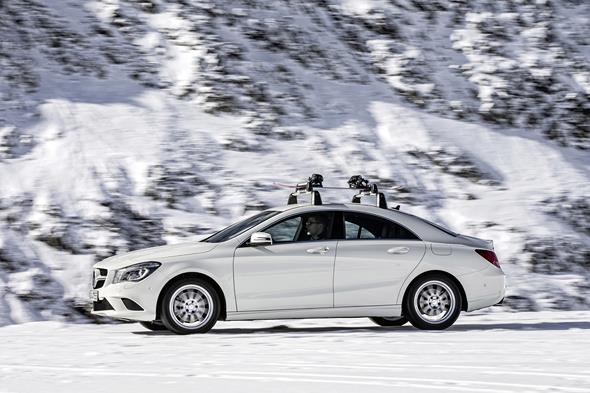
In case of impending understeer or oversteer under load, the drive torque is first of all distributed in such a way as to stabilise the vehicle. Only if these measures fail to have a stabilising effect do the control systems adapted to the conditions of 4MATIC, such as ESP® or 4ETS, intervene and keep the vehicle on course.
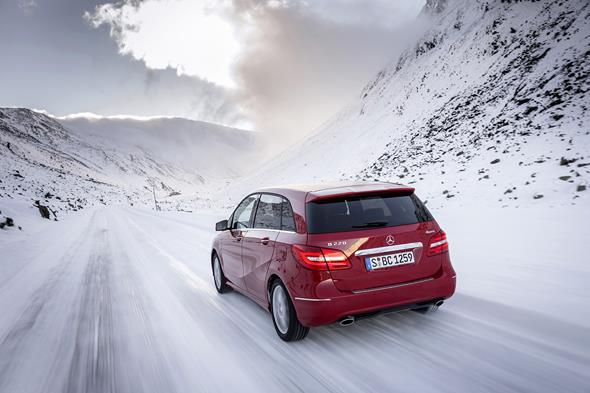
With this strategy, the developers have managed to combine two key requirements defined in the performance specifications: optimum energy efficiency coupled with maximum dynamic handling and driving safety.

Individual: transmission modes to suit personal driving styles
The torque distribution is also dependent on the activated shift program of the 7G-DCT dual clutch transmission. The ECO mode results in torque distribution of a more conservative nature. Less torque is channelled to the rear axle, resulting in gentler handling and supporting an economical driving style at lower revs.
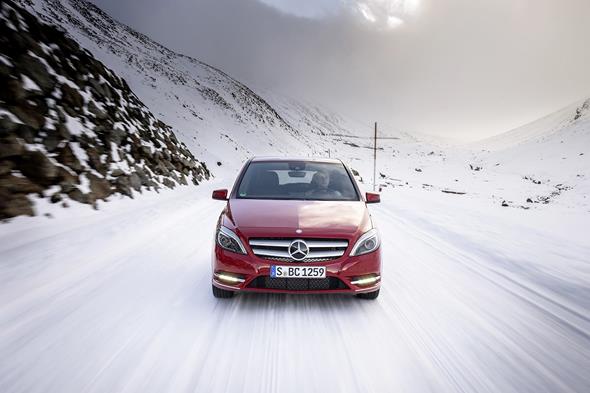
In SPORT or MANUAL mode the activation times are shortened and more torque is distributed to the rear axle in the interests of a dynamic, sporty driving style. GLA models with 4MATIC feature an off-road transmission mode as standard.
In this mode, the shift points and accelerator characteristics are also adapted in such a way that the requirements for driving on light off-road terrain and particularly on loose surfaces can be met. On the AMG versions of the A and CLA-Class, adaptation of the 4MATIC control system takes place in accordance with the 3-stage ESP®.
The pulse of a new generation: the Mercedes-Benz A-Class
With the new A-Class, Mercedes-Benz has opened up a new chapter in the compact segment: markedly emotive in design, dynamic, highly efficient and with a best in class Cd value of 0.27 (0.26 in the case of the BlueEFFICIENCY Edition).
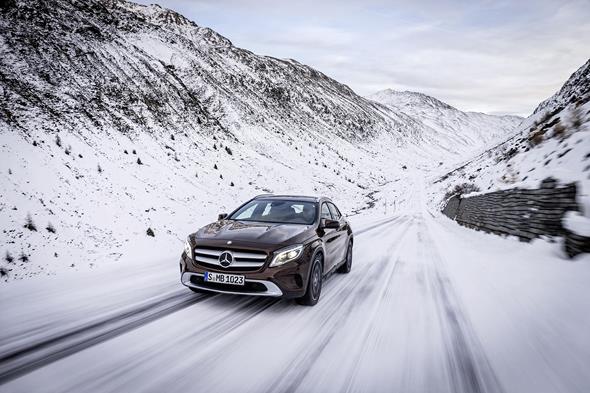
At the same time it underlines that for Mercedes-Benz, safety is not a question of price – the standard specification includes the radar-based COLLISION PREVENTION ASSIST system, for example.
Since the summer of 2013 the model range has been supplemented with the addition of the A 250 4MATIC. Its four-cylinder engine with a displacement of 1991 ccproduces 155 kW (211 hp) and delivers 350 Nm of peak torque between 1200 and 4000 rpm.
Performance is at sports car level, with acceleration from zero to 100 km/h in 7.1 seconds and a top speed of 230 km/h.
High performance in compact form: the A 45 AMG
The A 45 AMG offers an exciting introduction to the world of AMG. Mercedes-AMG has added emphatically sporty and muscular highlights to the emotionally appealing exterior design of the new Mercedes-Benz A-Class with its new dynamic style, sculptural character and feature lines along the sides.
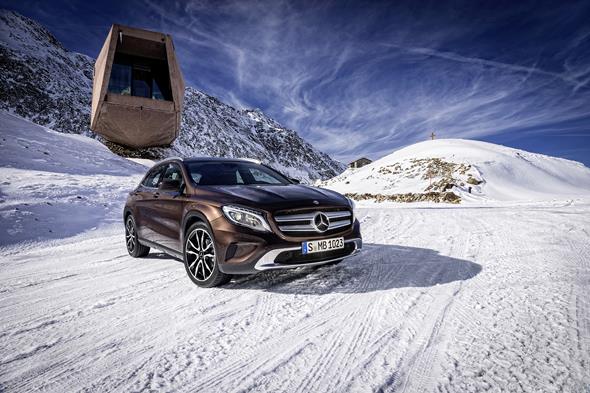
With an output of 265 kW (360 hp) and a peak torque of 450 Nm, the AMG 2.0-litre turbo engine is the world’s most powerful four-cylinder engine in series production.
The A 45 AMG comes with variable, performance-oriented AMG 4MATIC all-wheel drive as standard. The AMG SPEEDSHIFT DCT 7-speed sports transmission features seven gears, three distinct transmission modes, a double-declutching function dependent on the transmission mode and a RACE START function for optimum acceleration.
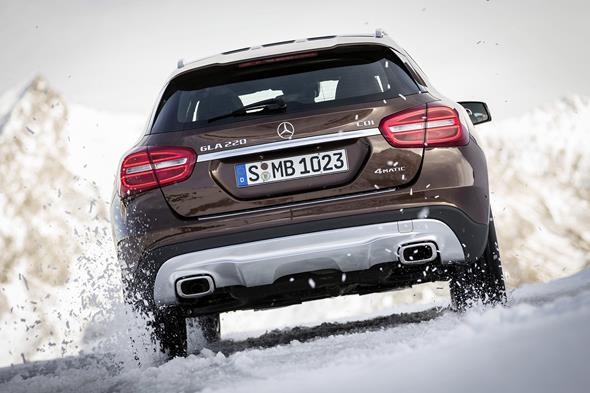
Like every AMG high-performance car, the A 45 AMG incorporates sophisticated axle technology. For enhanced dynamic handling, the McPherson front axle is fitted with stiffer steering knuckles and new elastokinematics.
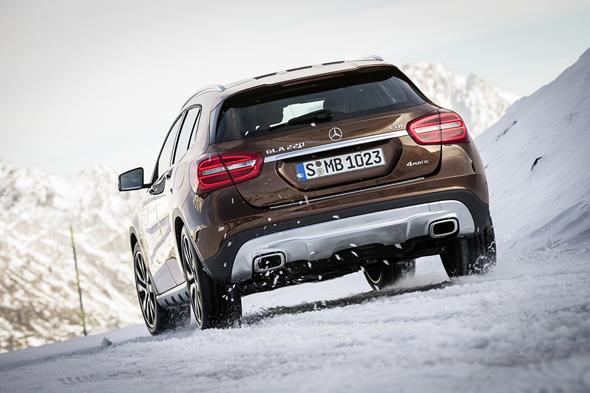
The 4MATIC models of the A-Class at a glance:
| Model | A 250 4MATIC | A 250 Sport 4MATIC | A 45 AMG |
| Number of cylinders/arrangement | 4 in-line | 4 in-line | 4 in-line |
| Displacement (cc) | 1991 | 1991 | 1991 |
| Rated output (kW/hp at rpm) | 155/211 at 5500 | 155/211 at 5500 | 265/360 at 6000 |
| Rated torque (Nm at rpm) | 350 at 1200-4000 | 350 at 1200-4000 | 450 at 2250-5000 |
| Combined fuel consumption from (l/100 km) | 6.5 | 6.6 | 6.9 |
| Combined CO2 emissions from (g/km) | 151 | 154 | 161 |
| Efficiency class | C | C | D |
| Acceleration 0-100 km/h (s) | 7.1 | 6.5 | 4.6 |
| Top speed (km/h) | 230 | 240 | 250 |
The sports tourer: the Mercedes-Benz B-Class
The second generation of the B-Class car has heralded a new compact class era at Mercedes-Benz in terms of both design and technology. The new B-Class is a typical Mercedes sports tourer, offering plenty of space combined with impressive dynamic performance in hatchback saloon form.
The B-Class features the radar-based collision warning system COLLISION PREVENTION ASSIST with adaptive Brake Assist as standard, which lowers the risk of a rear-end collision.
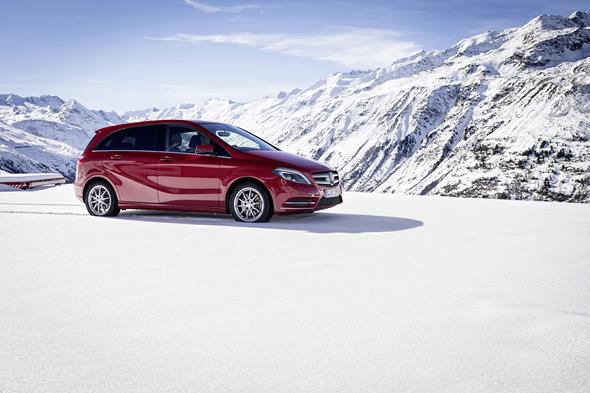
An outstanding drag coefficient of Cd = 0.26 (BlueEFFICIENCY Edition: 0.24) places the B-Class at the forefront of its market segment. Apart from the aerodynamic exterior design, numerous optimisation measures on points of detail such as the air flow around the front wheels, the underbody design and the cooling air flow are also crucial factors contributing to this excellent aerodynamic performance.
In September 2013, the first B-Class with all-wheel drive was launched in the guise of the B 220 4MATIC – and at the same time became the most cost-effective all-wheel drive Mercedes-Benz.

The specifications at a glance:
| Model | B 220 4MATIC |
| Number of cylinders/arrangement | 4 in-line |
| Displacement (cc) | 1991 |
| Rated output (kW/hp at rpm) | 135/184 at 5500 |
| Rated torque (Nm at rpm) | 300 at 1200-4000 |
| Combined fuel consumption from (l/100 km) | 6.5 |
| Combined CO2 emissions from (g/km) | 151 |
| Efficiency class | C |
| Acceleration 0-100 km/h (s) | 7.5 |
| Top speed (km/h) | 225 |
Sleek as they come: the Mercedes-Benz CLA-Class
With world-leading aerodynamics (Cd of 0.22 for the BlueEFFICIENCY Edition), avant-garde coupé design and optional 4MATIC all-wheel drive, the CLA is all set to establish a new segment.
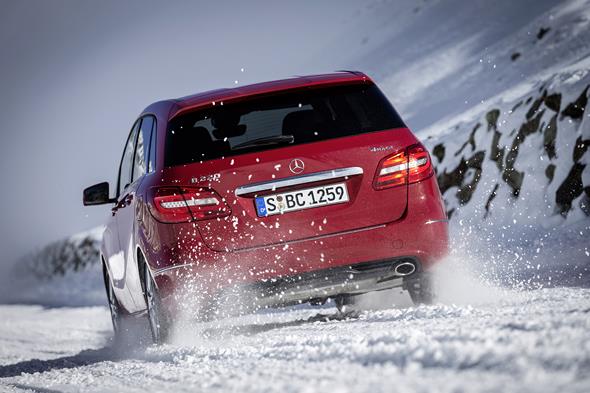
As a compact four-door coupé it follows the idea of the CLS, whose design concept has spawned more than its fair share of imitators since its debut in 2003. The CLA also comes as standard with a radar-based braking system (COLLISION PREVENTION ASSIST), which is able to warn the driver of an obstacle from a speed of 7 km/h and to initiate precision braking when the driver steps on the brake pedal.
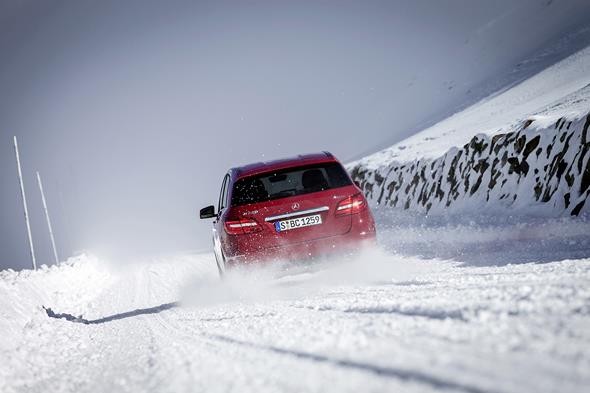
The CLA 250 4MATIC producing 155 kW (211 hp) features 4MATIC with fully variable torque distribution. It accelerates to 100 km/h from a standing start
in 6.6 seconds and has a top speed of 240 km/h. On average it consumes just 6.4 l/100 km, which corresponds to a CO2 level of 151 g/km.
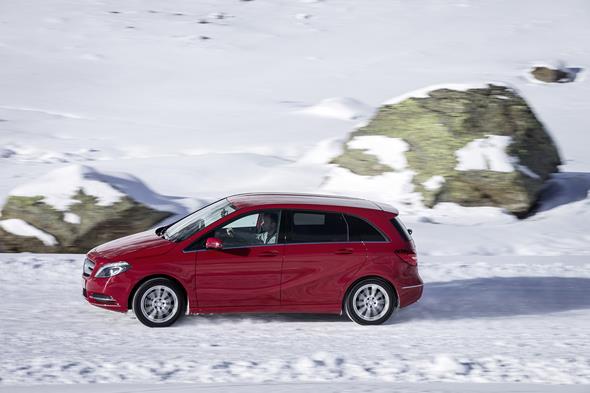
Since October the CLA 250 Sport has been available to order as a sporty, “engineered by AMG” series-production model.
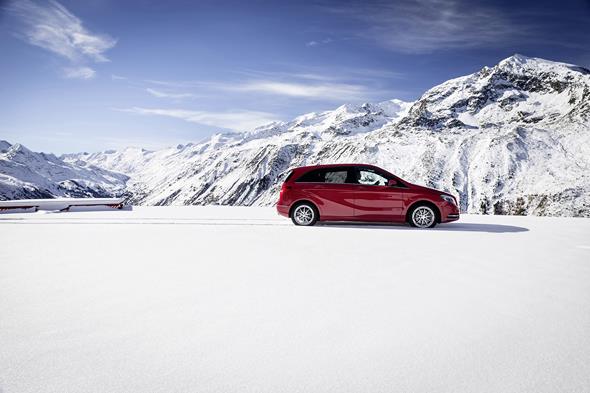
With its special engine and transmission configuration as well as an adapted ESP® set-up, the CLA 250 Sport additionally promises a very special driving experience, which is enhanced further by the emotion-stirring sound produced by the modified exhaust system.
Red detailing on the AMG front and rear aprons serves to further underline this model’s expressive positioning. The highlighting effect is carried through into the interior with designo seat belts in red.
Performance down to the smallest detail: the CLA 45 AMG 4MATIC
The CLA 45 AMG 4MATIC follows the philosophy of the CLS 63 AMG – the trendsetting four-door high-performance coupé.
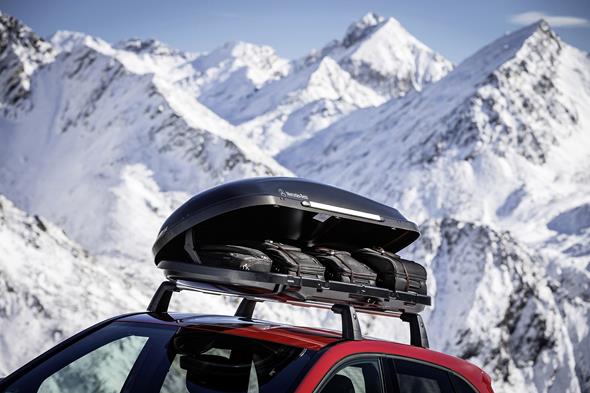
Just one glimpse of the high-tech package confirms that the four-door coupé also boasts the typical DNA and is the perfect embodiment of the AMG brand promise of Driving Performance: With a maximum output of 265 kW (360 hp) and a peak torque of 450 Nm, it not only boasts the world’s most powerful series production four-cylinder engine.
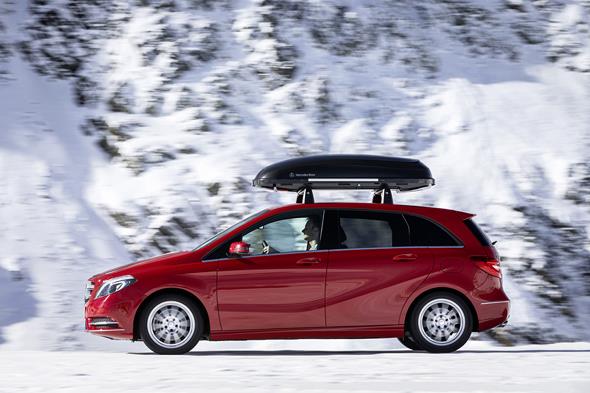
At the same time the turbocharged engine is also exceptionally efficient and meets the requirements of the EU6 emissions standard.
The 4MATIC models of the CLA-Class at a glance:
| Model | CLA 250 4MATIC | CLA 250 Sport 4MATIC | CLA 45 AMG 4MATIC |
| Number of cylinders/arrangement | 4 in-line | 4 in-line | 4 in-line |
| Displacement (cc) | 1991 | 1991 | 1991 |
| Rated output (kW/hp at rpm) | 155/211 at 5500 | 155/211 at 5500 | 265/360 at 6000 |
| Rated torque (Nm at rpm) | 350 at 1200-4000 | 350 at 1200-4000 | 450 at 2250-5000 |
| Combined fuel consumption from (l/100 km) | 6.4 | 6.6 | 6.9 |
| Combined CO2 emissions from (g/km) | 151 | 154 | 161 |
| Efficiency class | C | C | C |
| Acceleration 0-100 km/h (s) | 6.6 | 6.6 | 4.6 |
| Top speed (km/h) | 240 | 250 | 250 |
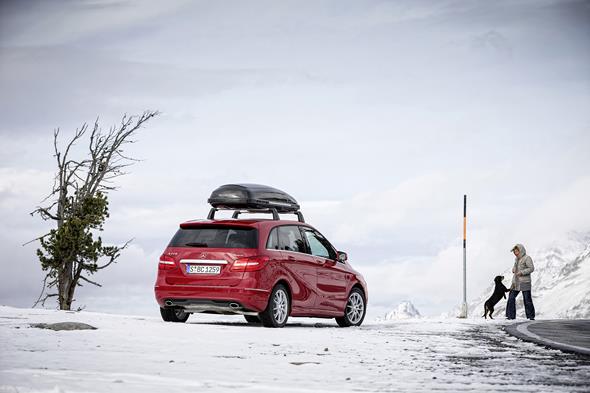
From 2014: the new Mercedes-Benz GLA-Class
Progressive in design, serene in day-to-day motoring and with good off-road capability: a wanderer between automotive worlds, the Mercedes-Benz GLA reinterprets the compact SUV segment in convincing style. It lightfootedly masters all day-to-day challenges and is also robust enough for off-road excursions.
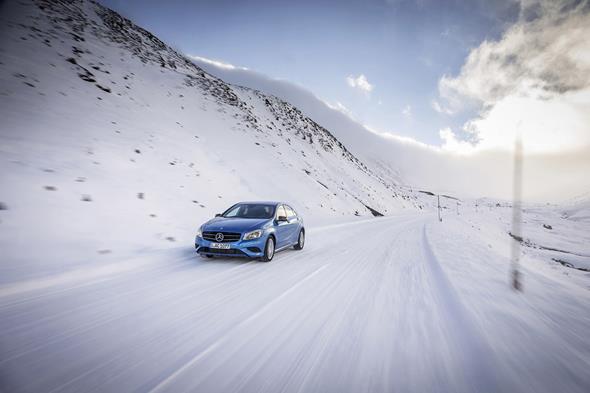
The new GLA is available to order from 29 November, and arrives in dealerships in 2014. With the GLA, yet another model series is set to become the leader in its segment with respect to aerodynamic efficiency. It has a Cd value of 0.29.
As the first Mercedes SUV, the GLA is available as an option with the new generation of 4MATIC permanent all-wheel drive with fully variable torque distribution.
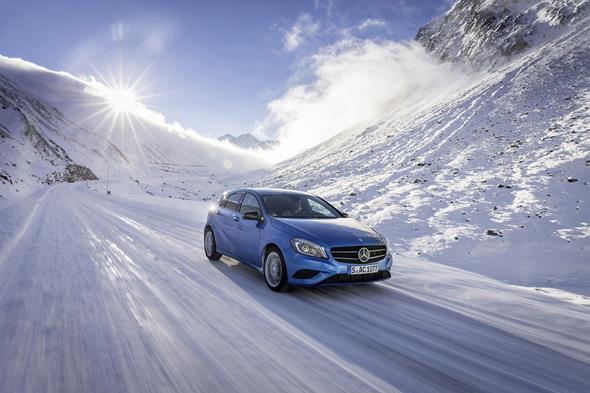
Models with 4MATIC are equipped with DSR (Downhill Speed Regulation) and an off-road transmission mode as standard. DSR is activated
by a control button in the centre console, and assists the driver on demanding downhill stretches by maintaining a slow, manually selected vehicle speed – as far as the physical limits allow – when negotiating downhill gradients.
This is done with the help of the engine and transmission control systems, and by specific braking intervention.
When the off-road transmission mode is selected using the transmission mode switch, the shift points and accelerator characteristics are modified so that the requirements for driving on light off-road terrain, and particularly on loose surfaces, can be met.
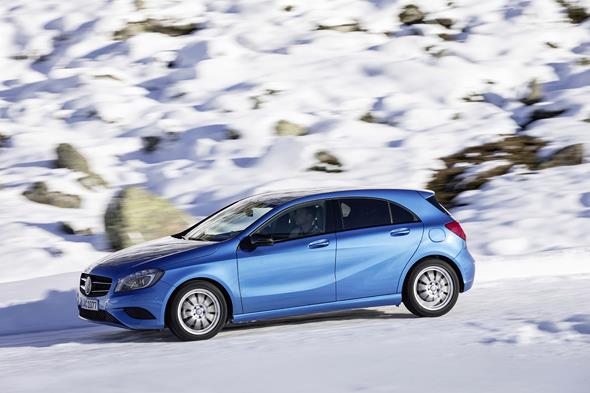
In combination with the Audio 20 CD (standard) and COMAND Online (optional extra), the head unit can also be switched to an On&Offroad display. The steering angle, the selected off-road transmission mode and a compass are displayed there.
The roll angle in degrees, the gradient in percent and activation of Downhill Speed Regulation DSR are also indicated. Broader and brighter illumination of the route is provided by the Off-road Light function (in conjunction with Intelligent Light System).
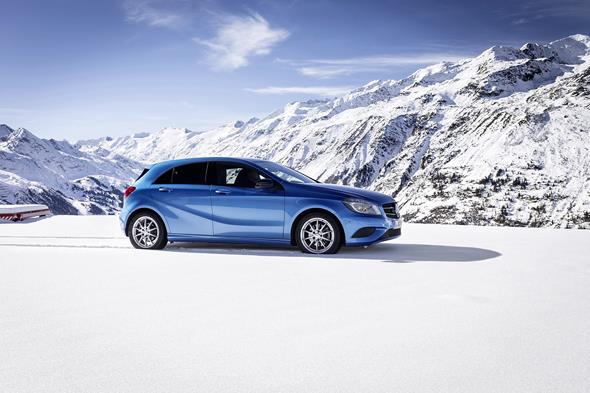
As part of this, the bi-xenon headlamps swivel outwards by 6 degrees, a symmetrical light distribution is set and the lighting output is increased.
The 4MATIC models of the new GLA-Class at a glance:
| Model | GLA 250 4MATIC | GLA 200 CDI 4MATIC | GLA 220 CDI 4MATIC |
| Number of cylinders/arrangement | 4 in-line | 4 in-line | 4 in-line |
| Displacement (cc) | 1991 | 2143 | 2143 |
| Rated output (kW/hp at rpm) | 155/211 at 5500 | 100/136 at 3400-4000 | 125/170 at 3400-4000 |
| Rated torque (Nm at rpm) | 350 at 1200-4000 | 300 at 1400-3000 | 350 at 1400-3400 |
| Combined fuel consumption from (l/100 km) | 6.5 | 4.9 | 4.9 |
| Combined CO2 emissions from (g/km) | 151 | 129 | 129 |
| Efficiency class | C | A | A |
| Acceleration 0-100 km/h (s) | 7.1 | 9.9 | 8.3 |
| Top speed (km/h) | 230 | 200 | 215 |
Even the best all-wheel drive is no substitute for winter tyres
Like any other all-wheel drive system, the 4MATIC versions have to abide by the laws of driving physics. The fundamental rule is that a tyre is only able to transfer a certain level of overall force to the road surface.
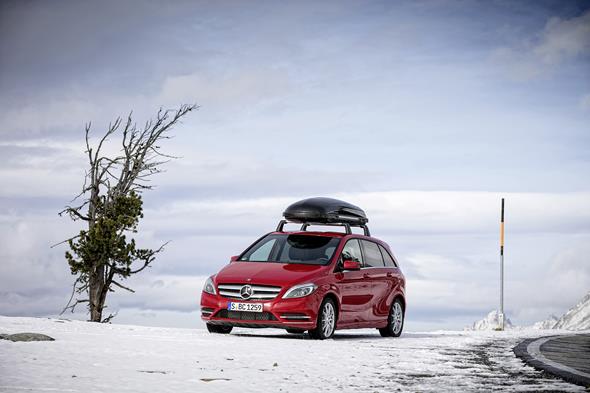
If a particularly high degree of longitudinal force is required during acceleration or braking, for example, the available lateral force is reduced. When cornering, the reverse applies: now a large amount of lateral force is required to keep the vehicle on course, while the longitudinal force potential is restricted.
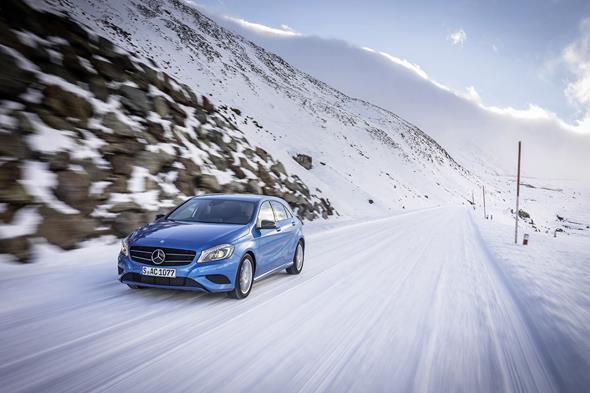
The engineers’ skill in designing the drive mechanism and fine-tuning the control systems lies in their ability to exploit these correlations in such a way as to ensure the best possible handling characteristics under all conditions.
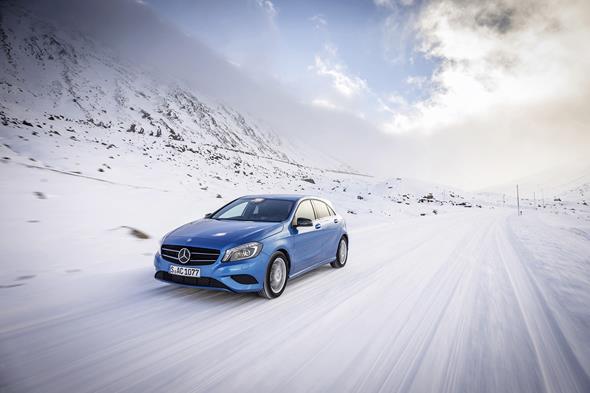
The frictional coefficient µ describes the physical grip between the tyres and the ground. This figure is high on a dry road (µ = 0.9) and low on a snow-covered road (µ = 0.3).
Despite all the engineers’ efforts, it is ultimately drivers themselves who determine how safe they are out on the road.
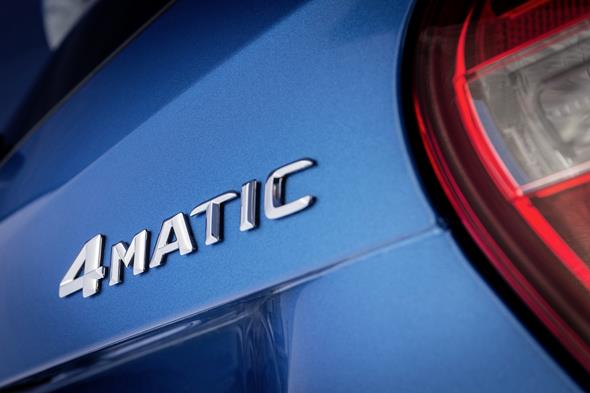
They should always adapt their driving style in accordance with the prevailing wintry conditions and ensure that their vehicle is suitably equipped; winter tyres are absolutely essential here.
A success story: the new generation of compact cars
The Mercedes-Benz attack in the premium compact segment continues: The Frankfurt Motor Show saw the presentation of the GLA as an impressive reinterpretation of the compact SUV segment.

The GLA is the fourth of five new models that mark a significant expansion of the brand’s product portfolio designed to appeal to new customer groups. As an example, the conquest rate of the new A-Class in Europe is at about 50 percent, and the average age of the customers is 10 years lower than with the predecessor model.
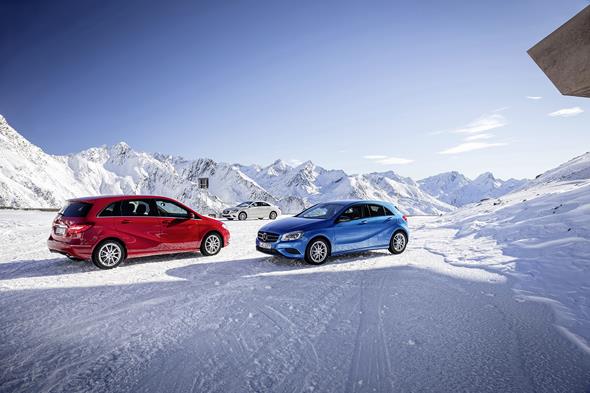
The new B-Class, new A-Class and the four-door CLA compact coupé already have a strong presence on the roads. Demand for these models continues
to be very high: from January through to October 2013 alone, no fewer than 303,599 vehicles from the A and B-Class and new CLA Coupé were delivered (+68.8%). Further momentum is expected in the months ahead with continuously rising availability in further markets.
